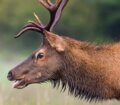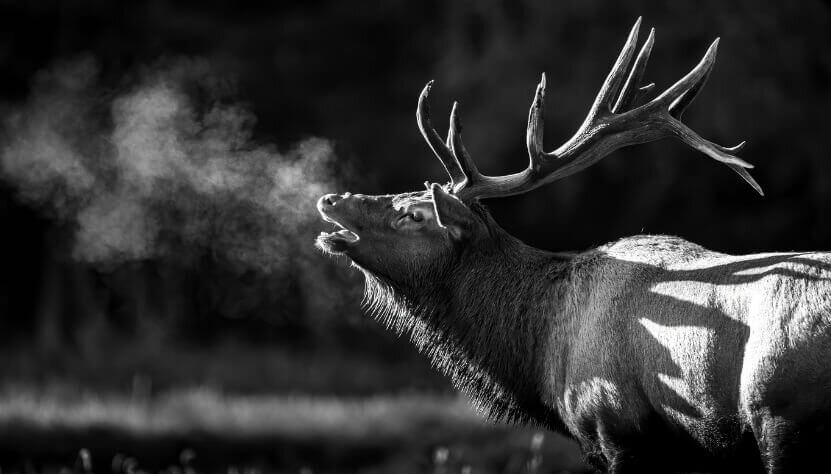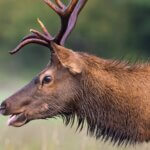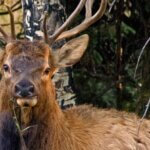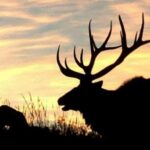Editor’s Note: Eddie Salter of Evergreen, Alabama, is known as Mr. Turkey – a title that speaks to his reputation of having won hundreds of turkey-calling contests and having had so-much success hunting gobblers. He’s also created turkey calls and sold them. Salter’s style of hunting is being aggressive. When he hears a turkey gobble, he wants to go to the tom and get as close as possible before taking him. Salter has learned that being a good turkey caller can make you a good elk hunter. (All artwork this week is courtesy of Dallen Lambson of Pocatello, Idaho, who’s won numerous awards, and has his artwork featured in Bass Pro Shops and Cabela’s stores.
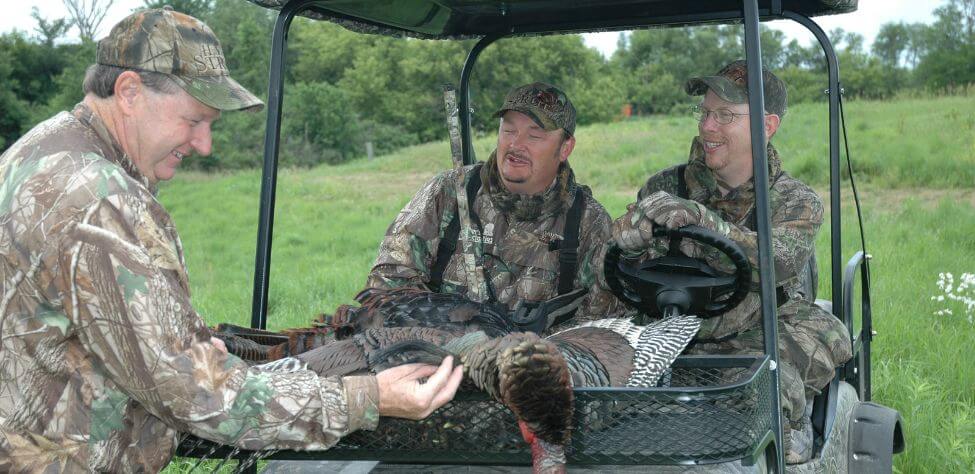
My guide for this 2005 hunt was Jimmy Hill, who passed away in 2022. I really miss him. He was a true elk guide. My friend Alex Rutledge of Missouri, and I decided to go on a hunt with him, but Alex didn’t get into camp until about three days after we started hunting. Jimmy had leased 2000 acres on the edge of the Jicarilla Apache Nation Indian Reservation that spans about 880,000 acres in north-central New Mexico and straddles the Continental Divide. The area includes high desert at 6,500 feet elevation and mountainous regions of 11,400 feet, made up of coniferous forests with rugged pine-covered mesas, pinion-juniper wood lands to low land sagebrush flats.
The three days before Alex arrived, we heard plenty of elk bugling. But we couldn’t get close to them. During those three days, I learned about elk calling and decided it was like calling turkeys – except that they sounded different. I also learned that each elk had a different personality, just like turkeys did.
Jimmy was using one of those sweet, soft calls most of the time and also an estrous whine call. To me, that sounded a lot like the cutting call I used when I was trying to make a turkey gobbler come within gun range. I always easily could cutt a series of clucks and yelps to a turkey with a few soft, fast yelps. I also could become demanding and give some high-pitched, loud cutting calls. I noticed that Jimmy was doing the same thing with his elk call when he was calling bulls. He’d start off with some soft, sweet, estrous cow sounds, and if the bull didn’t come into him, he’d get more aggressive with his calling – calling faster and louder.
By the third day, Jimmy was aggressive with his calling. In the beginning, when we’d bugle to the elk and give soft, sweet estrous calls, the bulls wouldn’t come in to where we were. Later Jimmy called hard with an estrous cow call.
On that third day we hunted, we went to a pretty meadow that once had had cows feeding on it. However, the cows had been taken off the land as winter approached. Then the elk moved down from the high country and fed in this 2,500-acre meadow. When we got out of the truck that morning, we heard the elk bugling from the meadow. As soon as we got close enough to use our binoculars, I saw 10-different bulls feeding in the meadow with their cows, chasing the cows around the meadow and bugling, making this one of my most-exciting hunts ever.

Once the skies brightened-up, and the sun rose over the mountain, the elk went to the top. We were only about 3⁄4-mile from Jimmy’s truck when he said, “Let’s go get something to eat. Then we’ll come back and start hunting around 2:00 pm when the elk come down the mountain to feed. So, we did. Afterwards Jimmy told Alex and me to sit where we were, and that when the elk began bugling, we’d know they were in the meadow but wouldn’t be able to go after them.
Where we sat, the vegetation was thick in some places. We got into the shade of a cedar tree to get cooler, since we’d been walking hard. At about 4:00 pm, we heard several bulls bugling. Because we were 300-400 yards from three of those bulls, we took our time to sneak down to where we thought the elk were feeding. Within 150 yards, Jimmy started calling, and the bulls began to answer him. He’d blow one of the sweet, estrous cow calls and then follow it with a louder, more-aggressive, estrous whine. Every time Jimmy called, the bulls answered back.
I remembered then that when I called turkeys, I used light clucks and yelps to make a turkey answer. I’d wait and wait for the tom to come in, and if he didn’t, I’d start giving some high-pitched cutting calls and usually fire a gobbler up. Next, Jimmy switched over and started bugling. I learned from Jimmy that just like you can change the sounds of a hen turkey, so that what the gobbler hears sounds like there are two or three hen turkeys where you are, Jimmy also switched-up his bugles. He’d make a dominant challenge bugle first that might get a bull to break from where he was and come to him. Then he’d use what he called a “social bugle” as though the bull was saying, “Hello, I’m over here” – a shorter version of a challenge bugle. Oftentimes, the cows would come to us, and the bull wouldn’t.”
Tomorrow: More Turkey Call Tactics for Elk
Expert Guidebooks on Elk Hunting: Best Sellers

Secrets for Hunting Elk
The quickest, easiest (if there is an easy way), and safest way to find and take that bull elk of a lifetime will be to hunt with a guide.
Chad Schearer, a longtime Montana guide and TV personality, told me, “My hunter is my gun. If I get to the elk, and my hunter isn’t with me, then we don’t take the elk. My job is not only to find the elk but also to help the hunter get to the elk and make the experience as enjoyable as I can for him.” That’s the kind of fella with whom I want to go elk hunting.
An elk hunt can be tough, but it doesn’t have to be so tough that you don’t enjoy it. That’s why this elk hunting book starts with the confessions of an elk guide and with Chad Schearer’s philosophy of what the guide and the hunter’s relationship should be.
A good portion of your success will depend on your physical condition, and Matt Morrett of Harrisburg, Pennsylvania explains how an eastern hunter can get ready physically during June and July to hunt western elk, the animals he describes as, “Like deer or turkeys on steroids.”
Wayne Carlton, well-known elk hunter and TV and video personality from Montrose, Colorado, tells us what types of elk calls to use and what to say to the elk. Mike Miller of Colorado, another elk guide and Mossy Oak video personality, has tactics for the best equipment for bowhunting and gun hunting elk.
You’ll learn helpful strategies and hunting tips in this book, as well as some straightforward hunting methods that will help to make your elk hunt more successful.
“Thanks to the advice in your elk hunting books, I was able to call up a nice 6-point (6X6) bull elk! He was bugling like crazy. I called him in from about a ¼ mile away. Called him into bow range (about 40 yards away). It was a thrill!” ~Rob Brannon
VERSIONS: AUDIBLE & KINDLE

Elk: Keys to 25 Hunters’ Success
Often just one tip or tactic makes the difference in whether you take an elk home to dinner or have to hike back to the truck by yourself. In John E. Phillips’ latest elk book, Elk: Keys to 25 Hunters’ Success, you’ll learn from successful elk hunters the strategies they use to find and take elk.
Many know that the technique that seems to work most often is to hunt where other elk hunters don’t and understand where the elk are before you go on a hunt by studying data from each state, visiting HuntData (see chapter 1), examining maps, and reading postings on elk forums.
This book also tells you how to get ready physically for an elk hunt, including participating in Train to Hunt Competitions, what gear you need to take, how to enjoy a successful do-it-yourself elk hunt, or how to pick the best elk guide for you. You’ll also hear about the X System and the Broken Y System of hunting elk.
Although no one person has all the answers on how to help you find and take your elk, I’m convinced that this book’s outdoors men and women will teach you how to have satisfying elk hunts.
As my friend Karl Badger once told me, “Elk hunting doesn’t get any better than when I ride horses into the high backcountry, see two grizzly bears, hear a pack of wolves howl close to camp all night long, eat plenty of delicious food prepared on a fire and enjoy the company of good friends.”
VERSIONS: AUDIBLE, KINDLE & PRINT

How to Find Your Elk and Get Him in Close will teach you the tactics of 10 nationally known elk hunters, to help put that giant bull that’s been screaming at you from afar, in your lap. You’ll learn what some of the best guides, outfitters, and successful elk hunters do to find elk and get them in really close.
Also in this audiobook, you’ll notice that the majority of the experts call elk to within bow range. We selected numerous bowhunters and bowhunting guides, since the bowhunter has to get much closer to a bull than the gun hunter does – often less than 20 or 30 yards – practically in your lap.
On one elk hunt, I’d heard this bull bugle all morning. My guide had called him within 30 yards, and he was standing just inside black timber. I saw the smoke from his nose wafting out into the icy air less than 30-yards away. All the bull had to do was step out, and I could take the shot with my bow. But then, through no fault of my guide or me, the bull vanished.
The only conclusion I could come up with to understand why the bull I wanted to take with my bow hadn’t stepped out and given me a shot, was because he got raptured. He evidently had left the earth with no trace of himself.
This hunt was when I started wanting to learn more about hunting elk up close. In this book, I’ve tried to find some of the most knowledgeable, experienced, and practical elk hunters. I’ve always found that the best way to learn any outdoor skill, is to either hunt or fish with the best sportsmen in that field.
Often, in elk hunting, that means elk guides, who generally hunt every day of the season and receive a salary for every hunter they guide. So, I’ve put together a group of some of the best elk hunters I know to help us all learn how to find bull elk and get them in close.
VERSIONS: AUDIBLE, KINDLE & PRINT

